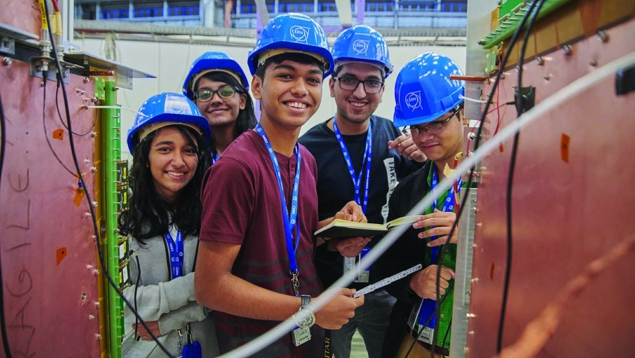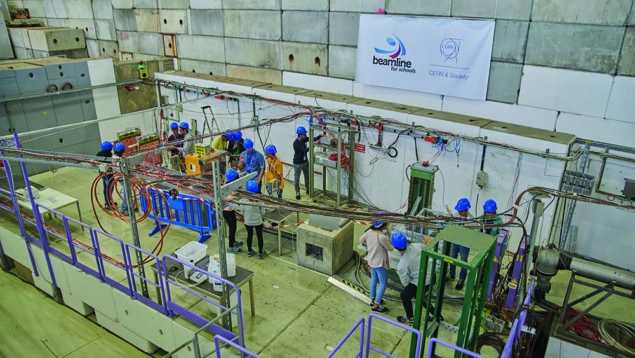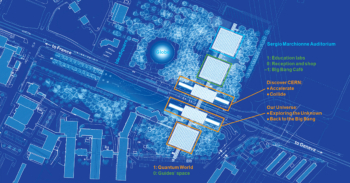Founded in 2014 at the time of CERN’s 60th birthday, the Beamline for Schools competition inspires and trains the youngest researchers in science.

Is it fun to learn physics from a textbook? According to many teenage participants in CERN’s Beamline for Schools (BL4S) programme, physics lessons at school are much too theoretical. Students from some countries do not even have physics lessons at all, let alone any contact with current science.
Many years back, in 2011, experimental particle physicist Christoph Rembser of CERN had an idea to get high-school students engaged with particle physics by offering them the chance to carry out their own experiment on a CERN beamline. Three years later, the 60th anniversary of CERN in 2014 offered an opportunity for what was meant to be a one-off worldwide science competition: BL4S was born. With the help of media attention in CERN around the time of the anniversary, teams of high-school students and their teachers were invited to propose an experiment at CERN. The response was overwhelming: almost 300 teams involving more than 3000 students from 50 countries submitted a proposal.
When the first two teams came to CERN in September 2014, it was clear that BL4S would not be a one-off event. Clearly the competition had the potential to attract large numbers of high-school students every year to get deeply involved with physics at the crucial stage in their education, two years before leaving school to take up further study. Ashish Tutakne, a member of the 2018 winning team from the Philippines, sums this up: “I believe the experience holds significant weight as it is not only a chance to collaborate with some of the smartest people in the world on a scientific project, it is also a taste of what conducting research is actually like. It is this experience that I believe that will in fact prove valuable to me … throughout the rest [of] my life.”
CERN and society
Thanks to the huge success of the first edition, institutes and foundations around the world also recognised the potential of the competition. Through the CERN & Society Foundation, an independent charitable organisation supported by private donors, BL4S has since been provided with the financial help without which it would not have been possible to turn the competition into an annual event. The CERN & Society Foundation has the aim of spreading CERN’s spirit of scientific curiosity for the benefit of society, and supports young talent through high-quality, hands-on training. This year, for example, in addition to the BL4S initiative, the foundation has helped more than 80 educators participate in CERN’s national teacher programme and granted more than 60 Summer Student scholarships.

So far, more than 900 teams with almost 8500 students from 76 countries have taken part in the BL4S competition, with one third of these students being female. While in the first edition in 2014 about 70% of the teams came from member states of CERN, this year roughly two-thirds of the participating teams were from associate and non-member states. This emphasises the international character of the competition and its global appeal.
The announcement of each edition of BL4S is usually made during the summer the year before, with a deadline for submitting a proposal of up to 1000 words and a one-minute video by 31 March. After about two months of evaluation, involving more than 50 volunteer physicists, the two winning teams and up to 30 shortlisted teams are announced in June. Besides certificates, which every participant receives, the shortlisted teams win special prizes such as BL4S T-shirts for every team member. The two winning teams are finally invited to CERN in September/October for a period of about 12 days to carry out their experiments.
Of course they are not doing this alone, but are guided by two professional scientists. These scientists, typically young PhD students in physics, make the largest contribution to the success of BL4S. They are not only responsible for the fine-tuning and implementation of the experiments of the winning teams but have, in collaboration with the CERN detector workshops, also developed bespoke devices for use in the BL4S experiments. Even though these support scientists were only involved with the project for less than a year, it offered them the opportunity to carry out a complete physics experiment from the beginning to the end; the skills that they acquired helped several of them to find interesting postdoc positions.
Beamline specifics
From the beginning, BL4S attracted a lot of CERN staff members as well as users and even retired staff to make voluntary contributions to the organisation of the event. This involves answering questions from the student teams, evaluating proposals, developing detectors and software, helping the winners with the analysis of the data, and many other things. These volunteers have become a crucial part of the competition.

CERN’s accelerator complex is vast, and is in constant use by thousands of physicists worldwide. Since the first edition, the BL4S experiments have taken place at the T9 beamline of the Proton Synchrotron fixed-target area in the “East Hall” on the main CERN site. This beamline offers a secondary beam with a momentum of 0.5–10 GeV/c and a mixture of electrons, pions, kaons, protons and some muons. Regarding detectors, CERN provides a range of technologies: scintillators, Cherenkov counters, delay wire chambers, multigap resistive plate chambers, micro-mesh gaseous structure detectors, lead-glass calorimeters and Timepix detectors. In addition, students are allowed to build their own detectors and bring them to CERN. For the triggering, NIM modules are used, while the data-acquisition system is based on the RCD-TDAQ system of the ATLAS experiment. The student teams are provided with a detailed document that describes all of these components.
The students are completely free with respect to the experiment and use of these materials as long as it does not raise any safety concerns. Quite often we are surprised by their creativity, and the ten winning proposals from the past five years illustrate the wide spectrum of their ideas (see table above). Besides these winning proposals, all of the proposals received show what captures the attention of curious teenagers. Just a few examples are: the shielding of spacecraft to protect astronauts from the dangers of cosmic radiation; the analysis of the atmosphere with respect to greenhouse gasses; the exploration of natural resources; the creation of artificial aurora borealis; and the artistic translation of signals of elementary particles into sights or sounds.
For a successful participation in BL4S, the role of teachers and other mentors is paramount. Many teachers do not feel confident enough and might not propose their students to take part in BL4S. Partly they feel not qualified enough for such a challenge or they do not get the support from their schools that is necessary to coach a team for many weeks if not months. After all, many teachers are severely limited in the time that they can devote to such activities. In some cases, the students go ahead without any mentors and complete their proposal in a self-directed way. In other cases, they contact physicists at local universities or at one of the national or regional contact points established in almost 30 individual countries. Usually, however, the main burden is on the teacher and we are very grateful to the many teachers who every year dedicate a substantial part of their free time to coach a team of students. Unfortunately, our surveys show that due to the high workload only a few teachers are able to participate several years in a row.
The effect that BL4S has on the many students that are not lucky enough to be invited to CERN is difficult to assess. We know, however, via feedback from several teachers, that BL4S is appreciated as a means of motivating their students. In addition, the students themselves often write that their participation was a great experience for them and many are even motivated to work on their proposals and improve them to take part again in the next edition.
The winning teams are encouraged to stay together after having been at CERN and to write a paper about their experiment. So far, three papers have been published in an international peer-reviewed journal, Physics Education, with the following titles: Building and testing a high school calorimeter at CERN; The secret chambers in the Chephren pyramid; and Testing the validity of the Lorentz factor (see further reading). Papers are typically published one to two years after the completion of the experiment. At least one further paper is currently in the pipeline. This is not a mandatory step for the teams, but it represents a unique opportunity to have authored a scientific publication before even starting at university.
According to a recent survey among the previous winners, most take up studies of natural sciences, engineering or mathematics. Max Raven of the 2016 winning team “Relatively Special” from Colchester Royal Grammar School in the UK remarked: “The most beneficial impact of BL4S has been the strong team-working and communication skills I developed… This invaluable experience has been instrumental to developing my interpersonal skills, which are vital for a successful career in engineering.” After taking part in the BL4S competition Raven was accepted to study engineering by the Massachusetts Institute of Technology.
Students and teachers alike are clearly very happy to be associated with the competition, and this also benefits CERN and its educational aims. Winning BL4S often creates a lot of media attention in the home region of the teams or even at the national level, and recently the two Italian teams that won BL4S in 2015 and 2017 were invited to the ministry of foreign affairs in Rome for a special ceremony. At the same time, BL4S makes a contribution to physics education by leading students into a field of physics rarely touched upon in school curricula. Being able to do hands-on physics with detectors and accelerators used also for other current experiments presents a huge motivation for students to learn even in their free time. Yash Karan, a member of the Philippine winning team in 2018, remarked: “I have learnt much more in the last two weeks at CERN than in the last six months in school!”
Next stop DESY
At the end of this year, CERN’s accelerator complex will be shut down for a period of two years to make way for maintenance and upgrades, in particular for the High-Luminosity LHC. This opens a new chapter in the history of the BL4S competition. In close collaboration with the DESY laboratory in Germany, the competition will continue there in 2019. DESY will provide beam time at the DESY II facility, offering electron and positron beams, and employ a dedicated support scientist on a three-year staff contract. Other institutes such as INFN-Frascati in Italy and the Paul Scherrer Institut in Switzerland are also interested in hosting the competition in the future.
What remains is the never-ending challenge of spreading the word. Even though CERN has many traditional and modern channels of communication, making BL4S known to high-school students and teachers around the world takes the effort of a large number of people at all levels. In particular, volunteers are needed to spread the word in their region and through their available channels, where they play several roles: acting as additional regional contacts for candidate teams; providing coaching if no teacher is available; taking part in the evaluation of proposals; assisting the winning teams with their data analysis and writing of scientific papers; and, finally, finding additional sponsors. Anyone interested can contact the BL4S team via bl4s.team@cern.ch.
As this article went to press, the 2018 winners were completing their experiments, which were hugely successful. All students claimed to have gained an immense increase in knowledge and they admired the passion that surrounded them everywhere they went at CERN. Working together in mixed shift crews each day, the teams have also learned about one another’s experiments, fostering cooperation and personal growth. Quotes such as “Beamline for Schools was a life-changing experience” are not uncommon, and many of this year’s students have made up their minds that they would like to pursue a career in particle physics or engineering.
The registration and proposal-submission for BL4S 2019 are now open. Hopefully the next edition will attract even more students from all around the globe to participate in this unique opportunity.
Further reading
http://beamline-for-schools.web.cern.ch.
L Biesot et al. 2016 Phys. Educ. 51 064002.
H Broomfield et al. 2018 Phys. Educ. 53 055011.
B Gutowski et al. 2018 Phys. Educ. 53 045011.





